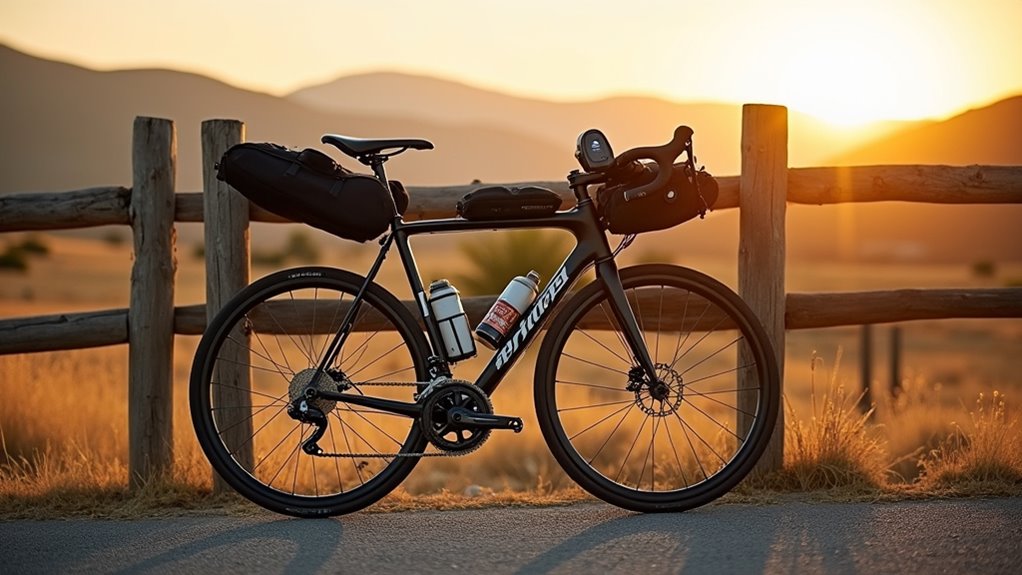Physical Address
304 North Cardinal St.
Dorchester Center, MA 02124
Physical Address
304 North Cardinal St.
Dorchester Center, MA 02124

Overlooking these critical long-distance cycling essentials could turn your dream ride into a nightmare rescue call.
Did you know that 73% of long-distance cyclists abandon their rides due to poor preparation rather than physical exhaustion? You’re probably thinking that sounds surprisingly high, but here’s the thing – most riders focus solely on building leg strength while completely overlooking the essential planning elements that make or break epic adventures. Whether you’re eyeing your first century ride or tackling multi-day tours, there’s a systematic approach that separates successful cyclists from those who end up calling for rescue.

Before you clip into your pedals and start spinning those wheels, you’ll want to map out your adventure carefully. Choose routes with bike-friendly roads, minimal traffic, and reasonable elevation changes that match your fitness level.
Successful cycling adventures begin with smart route planning that considers your abilities, road conditions, and safety factors.
Don’t forget to identify rest stops, water sources, and potential shelter spots every 15-20 miles.
Study weather patterns and wind directions – headwinds can turn a pleasant ride into a grueling battle. Download offline maps to your phone since cell service might be spotty.
Share your planned route with someone reliable, including estimated arrival times at key checkpoints.
Consider alternate routes in case of road closure or mechanical issues. Scout challenging sections beforehand if possible.
For multi-day adventures, consider incorporating RV camping spots along your route to enjoy nature while maintaining access to comfortable amenities and secure bike storage.
While your bike might be your most obvious companion on long rides, the gear you carry can make the difference between a memorable adventure and a roadside nightmare. Start with repair essentials: spare tubes, tire levers, multi-tool, and portable pump. Don’t forget chain lube and patches for unexpected fixes.
Pack smart clothing layers you can add or remove as conditions change. Weather-resistant jacket, extra socks, and gloves are non-negotiables. Your hydration system should include multiple water bottles or a hydration pack, plus electrolyte supplements.
Navigation tools like GPS devices or smartphone mounts keep you on track. Emergency items—first aid kit, emergency blanket, and cash—provide pivotal backup. Test all equipment beforehand; you’ll want everything working perfectly when miles from home.
If your cycling adventure takes you to Melbourne, consider staying at Greenhouse Backpackers for budget-friendly accommodation that caters to travelers exploring the city by bike.

Since your body becomes a high-performance engine during long rides, you’ll need to fuel it strategically rather than waiting until hunger strikes. Start eating within your first hour and continue consuming 200-300 calories every hour afterward. Choose easily digestible options like energy bars, bananas, or sports drinks that won’t upset your stomach.
Hydration’s equally critical—you should drink before you’re thirsty. Aim for 16-24 ounces per hour, adjusting for temperature and sweat rate. Plain water works for rides under two hours, but longer distances require electrolyte replacement through sports drinks or supplements. Signs of dehydration can be subtle at first, so monitor your body closely for early warning signals like decreased energy or mild headaches.
Practice your nutrition strategy during training rides. What works for others mightn’t work for you, so experiment with different foods and timing to discover your ideal fueling approach.
As your riding distances increase, your body needs time to adapt to the growing demands you’re placing on it. Build your endurance gradually by adding 10-15% more distance each week. Don’t jump from 20-mile rides straight to centuries – you’ll invite injury and burnout.
Gradual progression prevents injury – increase weekly mileage by 10-15% rather than making dramatic distance jumps that overwhelm your body.
Focus on consistent training rather than sporadic intense sessions. Mix long steady rides with shorter recovery spins and rest days. Your muscles grow stronger during recovery, not while you’re pedaling.
Post-ride recovery accelerates your progress. Stretch your hip flexors, hamstrings, and calves within 30 minutes of finishing. Ice baths reduce inflammation, while compression gear improves circulation. Prioritize sleep – aim for 7-9 hours nightly.
Listen to your body’s signals. Persistent fatigue, irritability, or declining performance indicate you need more recovery time. Consider incorporating tent camping into your long-distance cycling adventures for better rest and recovery compared to cramped RV accommodations.
You’ve got everything you need to conquer those challenging cycling adventures! Remember that preparation prevents poor performance, so don’t skip the planning phase. Trust your training, listen to your body, and maintain that steady, sustainable pace you’ve practiced. Weather won’t wait, so stay flexible and alert. Most importantly, enjoy every mile of your journey – you’ve earned this adventure through your dedication and determination. Ride safe, ride smart, and embrace the experience!